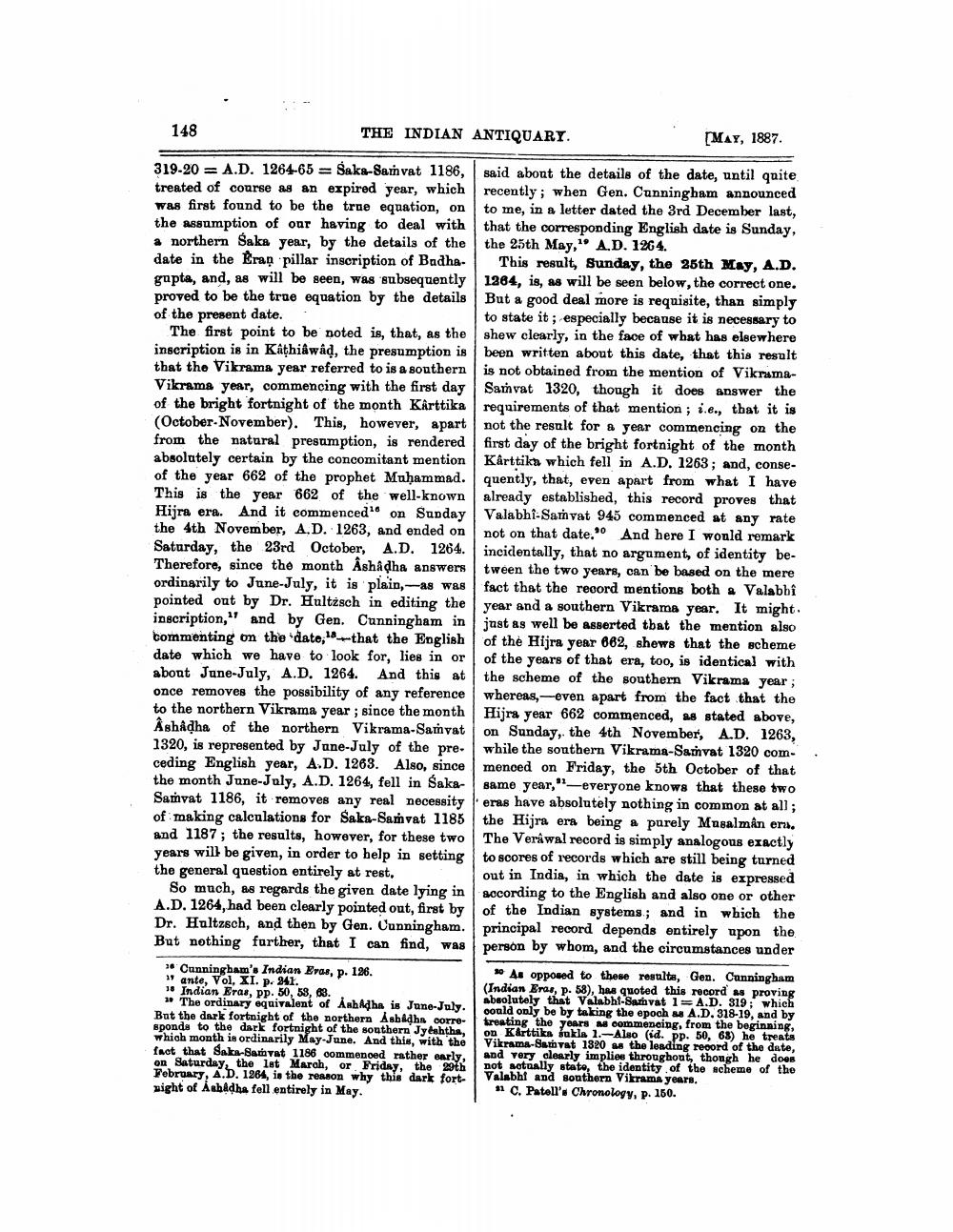________________
148
THE INDIAN ANTIQUARY.
MAY, 1887.
319-20 = A.D. 1264-65 = Saka-Samvat 1186, said about the details of the date, until quite treated of course as an expired year, which recently; when Gen. Cunningham announced was first found to be the true equation, on to me, in a letter dated the 3rd December last, the assumption of our having to deal with that the corresponding English date is Sunday, a northern Saka year, by the details of the the 25th May," A.D. 126 4. date in the Eraņ pillar inscription of Badha. This result, Sunday, the 25th May, A.D. gupta, and, as will be seen, was subsequently 1264, is, as will be seen below, the correct one. proved to be the true equation by the details But a good deal more is requisite, than simply of the present date.
to state it; especially because it is necessary to The first point to be noted is, that, as the shew clearly, in the face of what has elsewhere inscription is in Kathiawad, the presumption is been written about this date, that this result that the Vikrama year referred to is a southern is not obtained from the mention of VikramaVikrams year, commencing with the first day Sarvat 1320, though it does answer the of the bright fortnight of the month Karttika requirements of that mention ; i.e., that it is (October-November). This, however, apart not the result for a year commencing on the from the natural presumption, is rendered first day of the bright fortnight of the month absolutely certain by the concomitant mention Karttika which fell in A.D. 1263; and, conseof the year 662 of the prophet Muhammad. quently, that, even apart from what I have This is the year 662 of the well-known already established, this record proves that Hijra era. And it commenced on Sunday Valabhi-Samvat 945 commenced at any rate the 4th November, A.D. 1263, and ended on not on that date.And here I would remark Saturday, the 23rd October, A.D. 1264. incidentally, that no argument, of identity beTherefore, since the month AshAdha answers tween the two years, can be based on the mere ordinarily to June-July, it is plain,-as was fact that the record mentions both & Valabbi pointed out by Dr. Hultzsch in editing the year and a southern Vikrama year. It might. inscription," and by Gen. Cunningham in just as well be asserted that the mention also commenting on the date," that the English of the Hijra year 882, shews that the scheme date which we have to look for, lies in or of the years of that era, too, is identical with abont June-July, A.D. 1264. And this at the scheme of the southern Vikrama year; once removes the possibility of any reference whereas,-even apart from the fact that the to the northern Vikrama year; since the month Hijra year 662 commenced, as stated above, Â shảdha of the northern Vikrama-Samvat on Sunday, the 4th November, A.D. 1263, 1320, is represented by Jane-July of the pre- while the southern Vikrama-Samvat 1320 comceding English year, A.D. 1263. Also, since menced on Friday, the 5th October of that the month June-July, A.D. 1264, fell in Śaka- same year, "-everyone knows that these two Samvat 1186, it removes any real necessity eras have absolutely nothing in common at all; of making calculations for Saka-Saṁvat 1185 the Hijra era being a purely Musalman eru. and 1187; the results, however, for these two The Verawal record is simply analogous exactly years will be given, in order to belp in setting to scores of records which are still being turned the general question entirely at rest,
out in India, in which the date is expressed So much, as regards the given date lying in Bocording to the English and also one or other A.D. 1264, had been clearly pointed ont, first by of the Indian systems; and in which the Dr. Hultzsch, and then by Gen. Cunningham. principal record depends entirely upon the But nothing farther, that I can find, was person by whom, and the circumstances under Cunningham's Indian Eras, p. 126.
* As opposed to these results, Gen. Cunningham "ante, Vol. XI. p. 241. 16 Indian Eras, pp. 50, 58, 63.
(Indian Emas, p. 58), has quoted this record as proving
absolutely that Valabhi-Samvat 1= A.D. 319; which * The ordinary equivalent of Ash Adha is June-July. But the dark fortnight of the northern Asbląha corre-
could only be by taking the epoch A.D. 318-19, and by
treating the years m commencing, from the beginning, sponds to the dark fortnight of the southern Jyeshtha, on Karttiks sukla 1.-Also id. pp. 50, 68) he treats which month is ordinarily May-June. And this, with the Vikrama-Samvat 1920 as the leading record of the date, fact that Sala Samvat 1186 commenced rather early,
and very clearly implies throughout, though he does on Saturday, the 1st March, or Friday, the 20th not actually state, the identity of the scheme of the February, A.D. 1264, is the reason why this dark fort- Valabht and southern Vikrama years. vight of Åsbadha fell entirely in May.
11 C. Patell's Chronology, p. 150.




